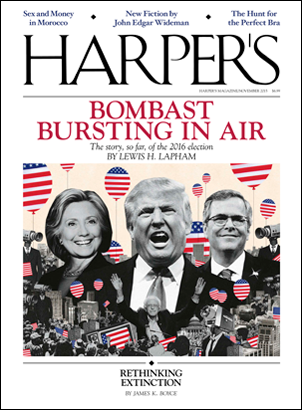Introducing the November Issue
Lewis H. Lapham discusses the presidential election, Barry C. Lynn reports on China’s leverage over the U.S. economy, Sallie Tisdale searches for the perfect brassiere, and more
 Americans won’t be going to the polls to elect the country’s next president for another year—and yet the nominating contest has already come to seem like a circus. This, Lewis H. Lapham says, in his vigorously argued cover Essay, is to be expected; it is what a too-complacent electorate deserves. The presidential race “is a ritual enactment of the legend of democracy as fairground spectacle: the proving that our flag is still there with star-spangled photo ops and bombast bursting in air.” The spectacle, Lapham warns, doesn’t come cheap. The eventual president, whoever he or she is, “can be counted upon … to stand four-square and true blue, for the freedom of money.” No one is better suited to topple the posturing political bobbleheads who constitute the current crop of presidential candidates than our own sharp-tongued editor emeritus.
Americans won’t be going to the polls to elect the country’s next president for another year—and yet the nominating contest has already come to seem like a circus. This, Lewis H. Lapham says, in his vigorously argued cover Essay, is to be expected; it is what a too-complacent electorate deserves. The presidential race “is a ritual enactment of the legend of democracy as fairground spectacle: the proving that our flag is still there with star-spangled photo ops and bombast bursting in air.” The spectacle, Lapham warns, doesn’t come cheap. The eventual president, whoever he or she is, “can be counted upon … to stand four-square and true blue, for the freedom of money.” No one is better suited to topple the posturing political bobbleheads who constitute the current crop of presidential candidates than our own sharp-tongued editor emeritus.
Barry C. Lynn’s Report on China’s economic power begins in a Ford dealership just north of Chongqing. While flipping through an English-language brochure, Lynn asks an employee if he owns a Ford. The employee shakes his head, but adds cheerfully: “I think maybe next year, I can buy one, too.” His optimism is good news for Ford, of course, but also for Walmart, Qualcomm, and every other American company that has invested in China’s vast marketplace. The bad news is that investing in an economy that is still controlled by a powerful state apparatus comes with certain risks—as the two Walmart employees who were jailed when the company was accused of mislabeling pork products in 2011 quickly learned. “What if,” Lynn asks, “the extreme economic interdependence between the United States and China is not actually carrying our values into a backward and benighted realm, but accomplishing precisely the opposite—granting the Chinese Politburo ever-increasing leverage over America’s economic and political life?”
“No one,” writes Sallie Tisdale, “can explain why women have continually swollen breasts.” This is just one of many mysteries surrounding the eternally mutable human breast. The breast can be pear-shaped or melon-shaped or conical; an individual breast usually weighs about one pound but can weigh over ten. “Breasts may lie near each other or be widely spaced; they may grow high on the chest or low,” she writes. “The nipples can point toward each other, away from each other, up, down, or straight ahead.” Given the abundance of variables, is it really any wonder that there is also an abundance of bras—and that despite this latter abundance, none of them truly seem to fit? In this month’s Miscellany, Tisdale sets out on a doomed but noble quest in search of that elusive object: the perfect brassiere.
Until the start of the twentieth century, passenger pigeons ruled the skies of North America. When Europeans first landed in the New World, the bird’s total population hovered somewhere between 3 and 5 billion. In 1855, a flock appeared in Columbus, Ohio, that was so large it blotted out the sun: “Children screamed and ran for home,” according to one contemporary account. “Women gathered their long skirts and hurried for the shelter of stores.” Less than sixty years later, they were extinct. In his investigation of the pigeon’s fate, James K. Boyce writes about efforts to breed a new strain of passenger pigeons using preserved genetic material—think Jurassic Park—and the meaning that project has for environmentalism. If we can turn back the clock on extinction, will that change the way we think about the ecological role humans can play?
Also in this issue: Sarah Dohrmann on Morocco’s prostitutes; Justin Taylor on Percival Everett; Ruth Franklin on American witch hunts; and Christine Smallwood on What the Eye Hears: A History of Tap Dancing, choreographer Agnes de Mille’s memoir Dance to the Piper, Mumbling Beauty Louise Bourgeois, a book of portraits of the artist—and Smallwood’s own tap-dancing ambitions.
One final bit of housekeeping: effective this week, the comments section of Harpers.org will be discontinued. Readers are invited to discuss our stories on Facebook and Twitter—something you’re already doing—and in the coming months we’ll be taking a more active role in fostering those conversations. Beginning with the December issue, we are also expanding the magazine’s Letters section. If you’d like to see your thoughts on an article in print and on our website, send us a letter. We’d love to hear from you.



